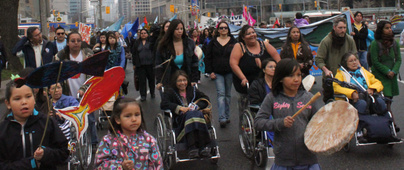Protesters demand action on Grassy Narrows
Toronto Star
Protesters demand action on Grassy Narrows
Grassy Narrows activist demand action from Mcguinty government

Residents from Grassy Narrows First Nation in northern Ontario lead about 250 protestors in a downtown march to Queen's Park to call on the Ontario government to acknowledge the long-term health effects of mercury contamination in their waterways. (April 7, 2010)
BRENDAN KENNEDY/TORONTO STAR
$12.7M in Prizes. 10 Properties.
One Big Prize After Another!
HelpConquerCancer.ca/LL#2492
About 250 people marched peacefully through downtown Toronto Wednesday afternoon to demand action from the Ontario government for the mercury poisoning they say has been occurring on the Grassy Narrows First Nation for decades.
“I think a lot of people in these buildings, in these cities, they don’t see … the devastation in our communities,” said Grassy Narrows resident, Judy Da Silva, who organized the rally.
Da Silva said the community’s waterways have become like “poison” to its people.
Grassy Narrows First Nation is a community of nearly 1,000 people about an hour’s drive northeast of Kenora.
“We still have a long journey to go to make the water clean again, to make the land alive again,” Da Silva said.
The protestors accuse the McGuinty government of not taking responsibility for allowing the Dryden Pulp & Paper Co. to dump 9,000 kg of mercury into the Wabigoon River between 1962 and 1970.
They called on the provincial government to acknowledge the long-term effects of mercury poisoning on the community, and demanded the federal government strengthen mercury regulations.
“We’ve been seeking justice for 40 years,” said Grassy Narrows Chief Simon Fobister. “Our health condition is worsening, generation after generation. This has got to stop.”
Health Canada says mercury levels in the community have fallen below their minimum guidelines, but residents and activists say the long-term effects of mercury poisoning continue to plague the community in the form of chronic health problems, birth defects and contamination of land and water.
The protest comes a day after a newly translated study of Grassy Narrows by Japanese scientist Dr. Masazumi Harada showed 79 per cent of 187 people tested in 2002 and 2004 had or may have had Minimata disease, a condition arising from exposure to methyl-mercury. Tremors, tunnel vision, impaired hearing and speech and loss of muscular co-ordination and sensation in the extremities are hallmarks of the condition.
Members of several organizations, including the Council of Canadians, Amnesty International and Greenpeace, joined about 40 members from Grassy Narrows, who travelled more than three days by car, rail and bus to attend the rally.
“There’s a certain kind of violence in telling people they can’t eat the fish they have been surviving on for generations,” said Meera Karunananthan, national water campaigner for the Council of Canadians.
The protestors, many carrying long stretches of blue fabric meant to resemble flowing water, marched from Grange Park, north on McCaul St., across College St. and north on University Ave. to Queen’s Park.
Harada first tested community members in 1975. He found people with mercury levels over three times the Health Canada limit in Grassy Narrows and seven times the limit in White Dog. When Harada returned in 2004, the people he tested in 1975 with mercury levels in their bodies considered above health guidelines were dead.
While the federal and provincial governments say contamination is no longer a problem, Harada's research indicates the possibility of congenital Minamata disease is high, said Ontario Regional Chief Angus Toulouse. Children are being born with neurological problems, mental deficiency and cerebral palsy, he said.
Premier Dalton McGuinty said Tuesday the province has a “heavy responsibility” to study Harada’s findings, because they conflict with the federal government's claim that mercury poisoning at Grassy Narrows is under control.
“It seems we have conflicting data and information,” McGuinty told reporters in Peterborough, where he was visiting a health clinic. “We have a report, apparently, which says we have a continuing problem and this contrasts with the federal government which is saying, ‘Well, things are under control.’”




